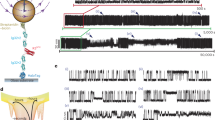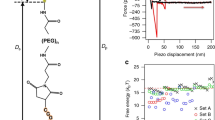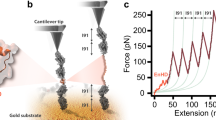Abstract
Atomic force microscopes and optical tweezers are widely used to probe the mechanical properties of individual molecules and molecular interactions, by exerting mechanical forces that induce transitions such as unfolding or dissociation. These transitions often occur under nonequilibrium conditions and are associated with hysteresis effects—features usually taken to preclude the extraction of equilibrium information from the experimental data. But fluctuation theorems1,2,3,4,5 allow us to relate the work along nonequilibrium trajectories to thermodynamic free-energy differences. They have been shown to be applicable to single-molecule force measurements6 and have already provided information on the folding free energy of a RNA hairpin7,8. Here we show that the Crooks fluctuation theorem9 can be used to determine folding free energies for folding and unfolding processes occurring in weak as well as strong nonequilibrium regimes, thereby providing a test of its validity under such conditions. We use optical tweezers10 to measure repeatedly the mechanical work associated with the unfolding and refolding of a small RNA hairpin11 and an RNA three-helix junction12. The resultant work distributions are then analysed according to the theorem and allow us to determine the difference in folding free energy between an RNA molecule and a mutant differing only by one base pair, and the thermodynamic stabilizing effect of magnesium ions on the RNA structure.
This is a preview of subscription content, access via your institution
Access options
Subscribe to this journal
Receive 51 print issues and online access
$199.00 per year
only $3.90 per issue
Buy this article
- Purchase on Springer Link
- Instant access to full article PDF
Prices may be subject to local taxes which are calculated during checkout




Similar content being viewed by others
References
Evans, D. J., Cohen, E. G. & Morriss, G. P. Probability of second law violations in shearing steady states. Phys. Rev. Lett. 71, 2401–2404 (1993)
Gallavotti, G. & Cohen, E. G. D. Dynamical ensembles in nonequilibrium statistical mechanics. Phys. Rev. Lett. 74, 2694–2697 (1995)
Ciliberto, S. & Laroche, C. An experimental test of the Gallavotti-Cohen fluctuation theorem. J. Phys. IV 8(Proc. 6), 215–220 (1998)
Evans, D. J. & Searles, D. J. The fluctuation theorem. Adv. Phys. 51, 1529–1585 (2002)
Wang, G. M., Sevick, E. M., Mittag, E., Searles, D. J. & Evans, D. J. Experimental demonstration of violations of the second law of thermodynamics for small systems and short timescales. Phys. Rev. Lett. 89, 050601 (2002)
Hummer, G. & Szabo, A. Free-energy reconstruction from nonequilibrium single molecule experiments. Proc. Natl Acad. Sci. USA 98, 3658–3661 (2001)
Liphardt, J., Dumont, S., Smith, S. B., Tinoco, I. Jr & Bustamante, C. Equilibrium information from nonequilibrium measurements in an experimental test of the Jarzynski equality. Science 296, 1832–1835 (2002)
Ritort, F., Bustamante, C. & Tinoco, I. Jr A two-state kinetic model for the unfolding of single molecules by mechanical force. Proc. Natl Acad. Sci. USA 99, 13544–13548 (2002)
Crooks, G. E. Entropy production fluctuation theorem and the nonequilibrium work relation for free-energy differences. Phys. Rev. E 60, 2721–2726 (1999)
Smith, S. B., Cui, Y. & Bustamante, C. An optical-trap force transducer that operates by direct measurement of light momentum. Methods Enzymol. 361, 134–162 (2003)
McManus, M. T., Petersen, C. P., Haines, B. B., Chen, J. & Sharp, A. P. Gene silencing using micro-RNA designed hairpins. RNA 8, 842–850 (2002)
Serganov, A. et al. Role of conserved nucleotides in building the 16S rRNA binding site for ribosomal protein S15. J. Mol. Biol. 305, 785–803 (2002)
Ritort, F. Work fluctuations, transient violations of the second law and free-energy recovery methods. Semin. Poincaré 2, 193–226 (2003)
Jarzynski, C. Nonequilibrium equality for free energy differences. Phys. Rev. Lett. 78, 2690–2693 (1997)
Park, S. & Schulten, K. Calculating potentials of mean force from steered molecular dynamics simulations. J. Chem. Phys. 120, 5946–5961 (2004)
Liphardt, J., Onoa, B., Smith, S. B., Tinoco, I. Jr & Bustamante, C. Reversible unfolding of single RNA molecules by mechanical force. Science 292, 733–737 (2001)
Zuckerman, D. M. & Woolf, T. B. Theory of systematic computational error in free energy differences. Phys. Rev. Lett. 89, 180602 (2002)
Gore, J., Ritort, F. & Bustamante, C. Bias and error in estimates of equilibrium free-energy differences from nonequilibrium measurements. Proc. Natl Acad. Sci. USA 100, 12564–12569 (2003)
Shirts, R., Bair, E., Hooker, G. & Pande, V. S. Equilibrium free energies from nonequilibrium measurements using maximum likelihood methods. Phys. Rev. Lett. 91, 140601 (2003)
Bennett, C. H. Efficient estimates of free energy differences from Monte Carlo data. J. Comp. Phys. 22, 245–268 (1976)
SantaLucia, J. Jr & Hicks, D. The thermodynamics of DNA structural motifs. Annu. Rev. Biophys. Biomol. Struct. 33, 415–440 (2004)
Robertus, D. J. et al. Structure of yeast phenylalanine tRNA at 3A resolution. Nature 250, 546–551 (1974)
Long, D. M. & Uhlenbeck, O. C. Self-cleaving catalytic RNA. FASEB J. 7, 25–30 (1993)
Cate, J. H. & Doudna, J. A. Metal binding sites in the major groove of a large ribozyme domain. Structure 4, 1221–1229 (1996)
Zuker, M. Mfold web server for nucleic acid folding and hybridization predictions. Nucleic Acids Res. 31, 3406–3415 (2003)
Turner, D. H. in Nucleic Acids: Structures, Properties and Functions (eds Bloomfield, D. A., Crothers, D. M. & Tinoco, I. Jr) Ch. 7 (Univ. Press, New York, 2000)
Carrion-Vazquez, M., et al. Protein nanomechanics studied by AFM single-molecule force spectroscopy. In Emerging Techniques in Biophysics (eds Arrondo, J. L. R. & Alonso, A.) (Biophys. Monogr. Ser., Springer, Heidelberg, in the press)
Milligan, J. F., Groebe, D. R., Witherell, G. W. & Uhlenbeck, O. C. Oligoribonucleotide synthesis using T7 RNA polymerase and synthetic DNA templates. Nucleic Acids Res. 15, 8783–8798 (1987)
Manosas, M. & Ritort, F. Thermodynamic and kinetic aspects of RNA pulling experiments. Biophys. J. 88, 3224–3242 (2005)
Hummer, G. Fast-growth thermodynamics integration: Error and efficiency analysis. J. Chem. Phys. 114, 7330–7337 (2001)
Acknowledgements
We thank G. Hummer and A. Szabo for many discussions and G. E. Crooks, D. Chandler and J. Liphardt for a careful reading of the manuscript. F.R. was supported by the Spanish Research council and the Catalan Government (Distinció de la Generalitat). C.J. was supported by an NIH grant and the US Department of Energy. I.T. was supported by an NIH grant. C.B. was supported by the Howard Hughes Medical Institute and the David and Lucile Packard Foundation.
Author information
Authors and Affiliations
Corresponding authors
Ethics declarations
Competing interests
Reprints and permissions information is available at npg.nature.com/reprintsandpermissions. The authors declare no competing financial interests.
Supplementary information
Supplementary Notes
This contains the Supplementary Discussion with Supplementary Figures and accompanying legends embedded in the text. This file also contains additional references. (PDF 505 kb)
Rights and permissions
About this article
Cite this article
Collin, D., Ritort, F., Jarzynski, C. et al. Verification of the Crooks fluctuation theorem and recovery of RNA folding free energies. Nature 437, 231–234 (2005). https://doi.org/10.1038/nature04061
Received:
Accepted:
Issue Date:
DOI: https://doi.org/10.1038/nature04061
This article is cited by
-
Thermodynamic fluctuation theorems govern human sensorimotor learning
Scientific Reports (2023)
-
Nonequilibrium thermodynamics for a harmonic potential moving in time
Journal of the Korean Physical Society (2023)
-
Classical theory of universal quantum work distribution in chaotic and disordered non-interacting Fermi systems
Scientific Reports (2022)
-
Fluctuation relations for irreversible emergence of information
Scientific Reports (2022)
-
Free energy and kinetic rate calculation via non-equilibrium molecular simulation: application to biomolecules
Biophysical Reviews (2022)
Comments
By submitting a comment you agree to abide by our Terms and Community Guidelines. If you find something abusive or that does not comply with our terms or guidelines please flag it as inappropriate.



